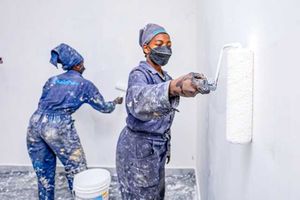
Arvind Shekhawat is the CEO of Kansai Plascon East Africa
The larger construction sector has been pushing its boundaries toward sustainability, and the paints industry is a front liner in that shift. The coatings industry has always been dynamic, with constant innovation disrupting the sector, every now and then.
DN2 Property talked to Arvind Shekhawat, the Chief Executive Officer of Kansai Plascon, East Africa, about the transition to sustainable paints.
He takes us back in time to over a century ago when the company was founded, through the intriguing journey of embracing biodiversity and sustainability in its operations — ultimately incorporating the painters, users, factory workers and the environment’s best interests.
What is the history behind Kansai Plascon and what are some of your biggest milestones?
Kansai Paint was founded in 1918 by Katsujiro Iwai, and has grown into one of top 10 global paint companies. Post World War II the company grew rapidly between 1948 and 1986. A key milestone was the listing on the Osaka, Tokyo, and Kobe stock exchanges in 1949.
Global expansion started as early as the 1980’s through various joint ventures in multiple countries. Several subsidiaries were acquired in the early 2000s across Asia, Europe, and the USA. Kansai Paint’s expansion into emerging markets took place as recently as 2010 with acquisitions in South Africa and Vietnam.

Participants take part in the 2019 Plascon Colour Run at Uhuru Gardens in Nairobi on August 11, 2019.
Focused on innovations
In recent years, the company has focused on innovations — one of our most exciting ones was demonstrating how its plaster coating can deactivate Covid -19 in 2020.
Kansai Paint acquired Plascon in South Africa in 2012, forming Kansai Plascon. Kansai Plascon East Africa was launched in 2016 with the acquisition of local paint businesses in 2017. The group company, Kansai Paint, operates in over 43 countries globally. On the African continent, Kansai Plascon operates in over 20 countries including Kenya, Uganda, Tanzania, Burundi, Malawi, Zambia, Zimbabwe, Botswana, Namibia and South Africa.
How has your product portfolio grown through the years?
To understand the humble beginnings of Kansai Paint and Plascon, one has to only look at the initial product offering of Plascon in South Africa back in 1889. The company founded by Herbert Evans, manufactured polishes and varnishes and then moved into ready tinted paints.
Kansai Plascon now offers multiple products, different grades of products and price points across the entire spectrum of paints including decorative, automotive, protective and industrial paints with 43 production sites across the globe. One of Kansai Paint’s key strengths is its research and development capabilities which sets our company apart and allows the group to provide unparalleled products and services around the world.
In 2018, Kansai celebrated its 100th anniversary — having been in the industry for so long, what are some of the most dynamic shifts you’ve lived through?
Paint products
One of the biggest changes in the paint industry has been the focus given to improving the health of the people making, using and living with paint products. For example, in the late 70s and the years that followed, the industry moved away from the use of lead and a lot of awareness was raised about the dangers thereof.
We have also embraced increasing care for the painter’s health while applying our products and shifted focus to the development of water-based paints. And now there is a lot of focus given to sustainability. Large companies such as Kansai Paint are transitioning to measuring, managing and setting metrics to achieve their sustainability goals.
Speaking of sustainability, could you elaborate on the practices the paints industry is embracing?
There are a number of practices globally such as the move towards water-based paints, which reduces the amount of volatile organic compounds (VOCs) released into the environment. Water-based paints emphasise the use of a renewable and more natural raw material — water. The use of renewable sources of raw materials and energies is a focus for most businesses these days.
The industry is also shifting to biodegradable and recycled raw materials which reduce the industry’s impact on the environment as components of the paint are biodegradable at the end of their life cycle. Recycled materials reduce the need for new raw materials — a fact that eases the pressure on resources. Businesses are also looking at their processes and how they can reduce waste, increase efficiencies, all while building robust and capable enterprises that can last generations, thereby, creating employment many years to come.
Has Kansai Plascon shifted to any sustainable business practices?
As the leading paint manufacturer in East Africa, we at Kansai Plascon, have to consider how sustainability impacts our value chain and our impact on the societies and the environments in which we operate.
The integration of Quality Management Systems (QMS), Environmental Management Systems and Occupational Safety and Health Systems into our production and supply chains via IMS ISO Certifications contributes to our sustainable practices.
I have a personal philosophy known as “grow our own timber” which refers to growing both the person and company hand-in-hand. We invest in skills development at Kansai Plascon, our staff receives training annually to upskill them for the demands of the business and to ensure that we remain relevant and competitive. All of these aspects lead to a sustainable and skilled workforce.
What about the products you make — how are you making them more sustainable?
This year we have subscribed to the Extended Production Responsibility Scheme. The scheme ensures all our post-consumer packaging waste material is sustainably managed and is in line with the Solid Waste Management Act of Kenya.
Fewer fumes
From a product perspective, our entire premium range of Plascon water-based products such as Vinyl Silk, Vinyl Matt, Weatherguard and Silicone Exterior Protection, from Kansai Plascon are all low VOC with less than 5 grams of VOCs per litre. Our paints are considered safer for the environment and human health because they have lower emissions and fewer fumes.
Traditional solvent-based paints release significant amounts of VOCs. Water-based paints, which use water as a solvent, drastically cut down VOC emissions and are less toxic. We are thorough with our research and development, striving to develop more water-based products that can substitute the solvent-based paints.
We are also focusing on waste reduction through our processes while maximising recycling within our manufacturing plants. We ensure that through our effluent treatment plant, we recover the dirty water from our production processes and use the same for cleaning purposes. With our solvent recovery plant, we recover organic solvents and recycle them to avoid dumping them into the environment.
One concern some might have is that sustainable paints might sacrifice performance. How does your company address?
Low VOC paints, in particular water-based paints, are not under performers. In fact, they have some unique benefits. They provide good colour consistency, they don’t yellow as quickly as some solvent-based paints, they dry quickly have good longevity.
In addition, the quality of our systems and products is in line with the principles of ISO 9001:2015, ISO 14001:2015 and ISO 45001:2018, which we integrate into our production and supply chain processes.
Beyond sustainability, what other exciting innovations have come up in the industry?
I think the intersection between paint and healthcare is an interesting development. Here in East Africa, Kansai Plascon has introduced anti-mosquito paint with the objective of becoming an additional vector against the spread of malaria and the terrible impact the disease has on children under the age of 5 years old. Our hygienic coatings are designed to enhance the appearance and durability of surfaces while also promoting good health and hygiene. An exciting global innovation is the move towards water-borne paints in the automotive segment.
What are some of the biggest challenges facing the wider paint industry in making a transition to more sustainable practices?
The development and access to affordable raw materials, or paint ingredients, that support sustainability is a challenge. Also many raw materials in East Africa are imported making paint companies dependent on imports, this requires a vast amount of transport, all of which use fossil fuels and release greenhouse gases. Overall, the supply chain’s unexpected disruptions such as war in various countries or the pandemic, impact costs which then affects products and the end users have to make tough choices regarding which products and what level of quality they are willing to spend on.
In terms of chromate and lead-free pigments, the alternatives tend to be more expensive than the existing products and in many cases the end-user is not ready to pay the higher price to get this more environmentally friendly product. This has to be one of the biggest challenges in producing sustainable paints.
Paints tend to be diverse depending on where they are to be used, who should consider investing in sustainable paint products or where should they be applied?
Everyone should consider sustainable options where they are available. Water-based paints are widely available and have the features to be used throughout one’s home or building project. For example, using Plascon Vinyl Silk in high traffic areas of the home where the family spends a lot of time such as the kitchen or living room where a washable, hard wearing and fashionable sheen product makes sense.
What other factors should consumers consider when choosing paints for different projects?
Plascon manuals
The first thing to consider when choosing paint is the area of use. Using the incorrect product will only result in a failure and cost money and time. It’s highly advisable to talk to an expert. Here at Plascon we have a call centre open to the public. Alternatively, read any of the Plascon manuals which give excellent advice on products and where they should be used.
What are your company’s long-term goals regarding sustainability in paint manufacturing?
In line with the Kansai Paint target for the elimination of Persistent Organic Pollutants the company is taking steps to comply with both the Stockholm Convention and Montreal Protocol to which Kenya is a signatory to ensure that we do not use any of the Persistent Organic Pollutants (POPs) listed by both agreements.
The Kansai Paint group has four key materiality topics, they are: decarbonisation, improving quality of life, enhancing resource and economic circulation, and diversity. They have been given KPI’s to achieve by 2030. The philosophy is that the group should pursue the 2030 KPI’s and that will put the company on the correct path to achieving the materiality topics by 2050.
The KPI’s are there to challenge each business to do things differently, taking large and necessary steps to achieve sustainability. Some of our Kansai Paint KPIs include a 30 percent reduction in greenhouse gases, 15 percent of energy sources to be renewable and 30 percent of management to be female, just to name a few.
Lastly, we are continuously conducting research and development to improve our products’ performance as well as meet sustainability goals. This research also reaches beyond the physical products as we consider using renewable energies and recycling at our offices and factories. We believe that paint has always played a part in maintaining or creating sustainability because a coated or painted surface will last longer.
Parting shot?
I believe the future is bright for East Africa and, specifically the Kenyan construction industry. We have invested in the region and continue to do so which will create more employment and further development for all stakeholders. With factories in Kenya, Uganda, Tanzania and exports into Rwanda, Burundi, South Sudan and the Democratic Republic of Congo, we are perfectly poised for sustainable growth in the region.









